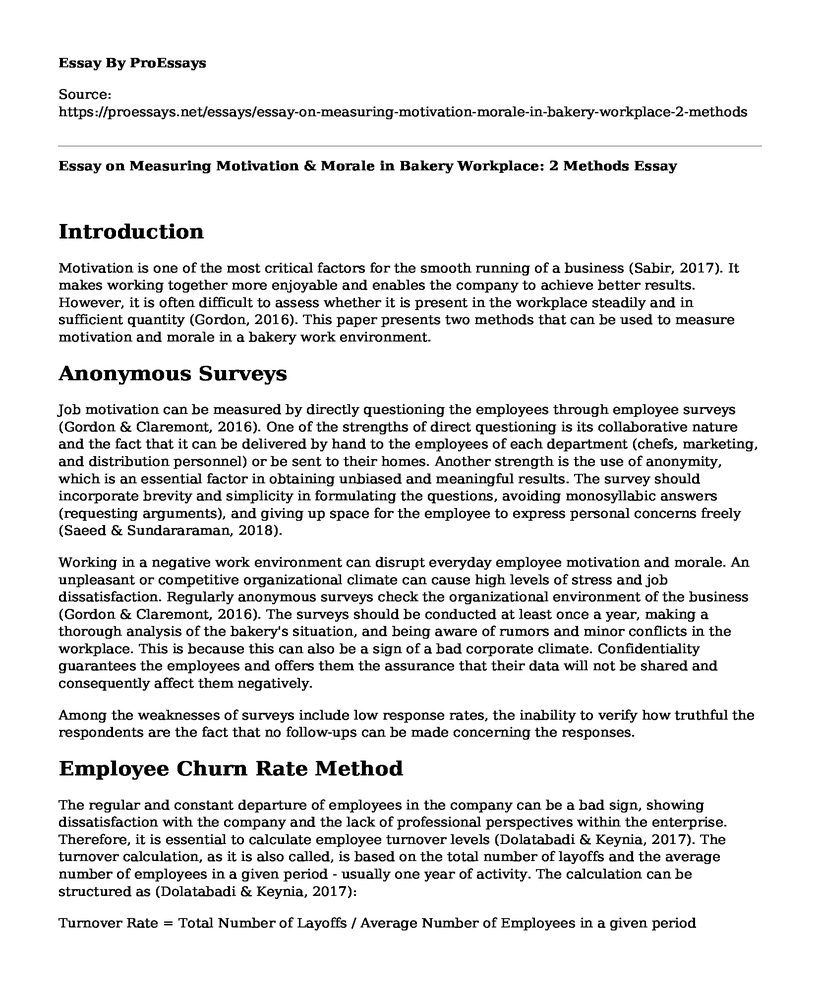Introduction
Motivation is one of the most critical factors for the smooth running of a business (Sabir, 2017). It makes working together more enjoyable and enables the company to achieve better results. However, it is often difficult to assess whether it is present in the workplace steadily and in sufficient quantity (Gordon, 2016). This paper presents two methods that can be used to measure motivation and morale in a bakery work environment.
Anonymous Surveys
Job motivation can be measured by directly questioning the employees through employee surveys (Gordon & Claremont, 2016). One of the strengths of direct questioning is its collaborative nature and the fact that it can be delivered by hand to the employees of each department (chefs, marketing, and distribution personnel) or be sent to their homes. Another strength is the use of anonymity, which is an essential factor in obtaining unbiased and meaningful results. The survey should incorporate brevity and simplicity in formulating the questions, avoiding monosyllabic answers (requesting arguments), and giving up space for the employee to express personal concerns freely (Saeed & Sundararaman, 2018).
Working in a negative work environment can disrupt everyday employee motivation and morale. An unpleasant or competitive organizational climate can cause high levels of stress and job dissatisfaction. Regularly anonymous surveys check the organizational environment of the business (Gordon & Claremont, 2016). The surveys should be conducted at least once a year, making a thorough analysis of the bakery's situation, and being aware of rumors and minor conflicts in the workplace. This is because this can also be a sign of a bad corporate climate. Confidentiality guarantees the employees and offers them the assurance that their data will not be shared and consequently affect them negatively.
Among the weaknesses of surveys include low response rates, the inability to verify how truthful the respondents are the fact that no follow-ups can be made concerning the responses.
Employee Churn Rate Method
The regular and constant departure of employees in the company can be a bad sign, showing dissatisfaction with the company and the lack of professional perspectives within the enterprise. Therefore, it is essential to calculate employee turnover levels (Dolatabadi & Keynia, 2017). The turnover calculation, as it is also called, is based on the total number of layoffs and the average number of employees in a given period - usually one year of activity. The calculation can be structured as (Dolatabadi & Keynia, 2017):
Turnover Rate = Total Number of Layoffs / Average Number of Employees in a given period
Ideally, the rate should be around 5%; higher numbers should be carefully analyzed by the business's leadership. If employees are leaving the company, it's an indicator of a lack of motivation.
There is a positive correlation between layoffs and employee satisfaction (Choi & Joung, 2017). In general, companies that do not evaluate employee satisfaction indicators end up firing them without planning. The consequence of layoffs range from increased turnover costs; material and intangible losses (such as the training time and qualification of new employees and the fall of productivity indicators during the turnover period); and more importantly, the company does not deal with the problem since the dissatisfaction of its employees may be the demotivating factor in the many layoffs and losses (Han, Bonn & Cho, 2016). One of the strengths of the method is its capacity to set an optimal turnover rate, which can be calculated internally to know if workers are motivated - or not - or it's under control.
Among the weaknesses of this method is that it offers a wide range of possibilities for employees leaving or joining the company without motivation being a factor. The workers may leave for personal reasons without necessarily being unmotivated, thus challenging reliable evaluation.
References
Choi, E. K., & Joung, H. W. (2017). Employee job satisfaction and customer-oriented behavior: A study of frontline employees in the foodservice industry. Journal of Human Resources in Hospitality & Tourism, 16(3), 235-251.
Dolatabadi, S. H., & Keynia, F. (2017, July). Designing of customer and employee churn prediction model based on data mining method and neural predictor. In 2017 2nd International Conference on Computer and Communication Systems (ICCCS) (pp. 74-77). IEEE. DOI: 10.1109/CCOMS.2017.8075270
Gordon, A. (2016). An examination of performance appraisal systems in light of employee motivation. International Journal of Management and Humanities, 2(2), 1-4.
Gordon, J. S., & Claremont, C. A. (2016). Bringing Morale Back to the Workplace: A Collaborative Change Project. Retrieved from http://capstones.claremontlincoln.edu/Gordon.pdf
Han, S. J., Bonn, M. A., & Cho, M. (2016). The relationship between customer incivility, restaurant frontline service employee burnout and turnover intention. International Journal of Hospitality Management, 52, 97-106. Retrieved from http://dx.doi.org/10.1016/j.ijhm.2015.10.002
Sabir, A. (2017). Motivation: Outstanding Way to Promote Productivity in Employees. American Journal of Management Science and Engineering, 2(3), 35-40. Retrieved from doi: 10.11648/j.ajmse.20170203.11
Saeed, F., & Sundararaman, V. (2018). Employee performance evaluation in agile work environment. Retrieved from http://www.diva-portal.org/smash/get/diva2:1229358/FULLTEXT02
Cite this page
Essay on Measuring Motivation & Morale in Bakery Workplace: 2 Methods. (2023, Mar 13). Retrieved from https://proessays.net/essays/essay-on-measuring-motivation-morale-in-bakery-workplace-2-methods
If you are the original author of this essay and no longer wish to have it published on the ProEssays website, please click below to request its removal:
- Paper Example on Communication Skills and Conflict Resolution in Nursing
- My Contribution to Advancing Positive Social Change through Nursing
- External Auditors That Don't Doing Quality Audit Work Articles Review
- Essay Sample on My True Color Description
- BSCI Study on Employee Exposure to Particulates & Gases
- Essay Sample on Understanding Business Communication
- Essay Example on Highly Motivated Marketer: Unlocking Potential in Business & Marketing







